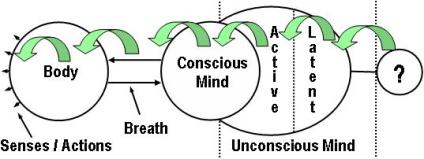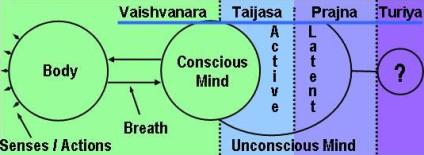|
|
Hard Problem of
Consciousness
Not a Problem for
Yoga
Swami Jnaneshvara
Bharati
WHAT IS THE "HARD PROBLEM OF CONSCIOUSNESS"?
The question of the hard problem of consciousness
started with a 1994 talk by David Chalmers in Tucson, Arizona, and has
been widely discussed and written about since then. The gist of the hard
problem of consciousness is that main stream science has not yet figured
out how humans can have subjective awareness. It is not my intent here
to try to replicate the many descriptions of the hard problem of
consciousness by people far more qualified to explain the issue. Some
links are below to help you start to explore this if the subject is new
to you.
The point of this short article is to briefly
introduce the idea that the yogis have been exploring consciousness for
thousands of years and find no "hard problem of consciousness." At the
heart of the difference between the views of science and scientists and
the views of yoga and yogis is that science and scientists see
consciousness primarily as somehow emerging out of the chemistry of the
physical brain, whereas yoga and the yogis see consciousness as
independent of the brain, although operating outward through the
physical instrument of brain.
DESCRIPTIONS OF THE HARD PROBLEM OF CONSCIOUSNESS:
Google search on the "hard
problem of consciousness" (at least 70,000 entries)
Wikipedia on the Hard Problem of Consciousness
"The hard
problem of consciousness is
the problem of explaining how and why we have qualia or phenomenal
experiences—how
sensations acquire characteristics, such as colors and tastes."
YouTube by
David Chalmers on the Hard Problem of Consciousness
“Right now you have a movie playing inside your head,” says philosopher
David Chalmers. It’s an amazing movie, with 3D, smell, taste, touch, a
sense of body, pain, hunger, emotions, memories, and a constant
voice-over narrative. “At the heart of this movie is you, experiencing
this, directly. This movie is your stream of consciousness, experience
of the mind and the world.”
This is one of the fundamental aspects of existence, Chalmers says:
“There’s nothing we know about more directly…. but at the same time it’s
the most mysterious phenomenon in the universe.” What is the difference
between us and robots? Nobody knows the answers.
For much of 20th century, Chalmers says, an idea that there could be no
scientific study of consciousness held sway: Psychologists studied
objective facts about behavior, neuroscientists studied the material of
the brain. About 20 years ago that started to change. Prominent
scientists like Francis Crick and Roger Penrose started saying: Now is
the time to attack this problem. “This has been wonderful, and great,
but also has limitations.” Principally, the work so far has been a
search for correlations between areas in the brain and conscious states.
As he says, “This is still a science of correlations, not explanations.”
Chalmers believes the questions answered so far — mainly, about what
parts of the brain do which bits of processing — are the “easy” (in
comparison) problems. The hard problem is why is it that all that
processing should be accompanied by this movie at all.
Internet Encyclopedia of
Consciousness on the Hard Problem of Consciousness
"The hard problem of consciousness is the problem of explaining why any
physical state is conscious rather than nonconscious. It is the problem
of explaining why there is “something it is like” for a subject in
conscious experience, why conscious mental states “light up” and
directly appear to the subject. The usual methods of science involve
explanation of functional, dynamical, and structural
properties—explanation of what a thing does, how it changes over time,
and how it is put together. But even after we have explained the
functional, dynamical, and structural properties of the conscious mind,
we can still meaningfully ask the question: Why
is it conscious?"
Why can't the world's great minds solve the mystery of consciousness?
YOGA AND CONSCIOUSNESS:
The thousands of years history of yoga has been primarily about the
exploration of consciousness.
YOGA AND PHYSICAL
EXERCISE: The view that yoga is about physical exercise is a fairly
recent innovation. That is not the orientation of yoga used in this
article. I do not wish to argue the point with anybody. However, those
who see yoga as being about physical fitness are not likely to
understand anything at all about the points being suggested here.
YOGA AND RELIGION: The
view the yoga is about religion is simply wrong. When the net of
religion was cast over the world in the recent few hundred years, yoga
was caught in that net and incorrectly seen as being part of religion
rather than as the exploration of consciousness that it really is. Those
who think yoga is religion are not likely to understand anything at all
about the points being suggested here.
CONSCIOUSNESS MOVES
OUTWARD: The basic principle of yoga is that consciousness moves outward
through what may be called levels, layers, or stages of manifestation.
One of the later aspects of this manifesting process is as consciousness
operates outward through the physical body, brain, and the central
nervous system. Thus, the hard problem of consciousness simply does not
exist.

Those major levels of
manifestation are consciousness (Atman) moving outward through three
general levels known as prajna, taijasa, vaishvanara, the last one of
which includes the physical body and brain.

MANDUKYA UPANISHAD:
There is a twelve verse text which outlines this manifesting process.
That text is the Mandukya Upanishad, and is about consciousness, not a
religion text. Here are the twelve
verses of Mandukya Upanishad.
OUR TRADITION:
Our tradition is a purely meditative
tradition of the Himalayas and is not linked with any religion. From the
perspective of our tradition, the levels of consciousness are universal,
and are to be explored by each person in his or her own direct
experience. Our thousands of years old tradition is most recently
exemplified by Swami Rama, who was my own
personal guide in these principles and practices. Here are links to some
video lectures by Swami Rama which will explain the true nature of yoga
and the levels of consciousness in the Mandukya Upanishad. They are
rather lengthy, but if any of this page has caught your attention, will
be very insightful for you in seeing this perspective that the hard
problem of consciousness is not a problem for yoga.
-------
This site is devoted to
presenting the ancient Self-Realization path of
the Tradition of the Himalayan masters
in simple, understandable and beneficial ways, while not compromising
quality or depth. The goal of our sadhana or practices is the highest
Joy that comes from the Realization in direct experience of the
center of consciousness, the Self, the Atman or Purusha, which is
one and the same with the Absolute Reality.
This Self-Realization comes through Yoga meditation of the Yoga
Sutras, the contemplative insight of Advaita Vedanta, and the
intense devotion of Samaya Sri Vidya Tantra, the three of which
complement one another like fingers on a hand.
We employ the classical approaches of Raja, Jnana, Karma, and Bhakti
Yoga, as well as Hatha, Kriya, Kundalini, Laya, Mantra, Nada, Siddha,
and Tantra Yoga. Meditation, contemplation, mantra and prayer
finally converge into a unified force directed towards the final
stage, piercing the pearl of wisdom called bindu, leading to the
Absolute.
|
|